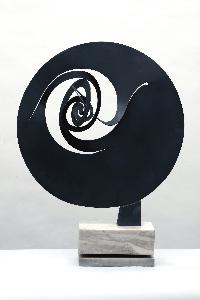Enio Iommi Girola
Enio Iommi Girola;Enio Iommi
장소: Rosario
타고난: 1926
죽음: 2013
전기:
Enio Iommi Girola was a renowned Argentine visual artist, born on March 20, 1926, in Rosario, Argentina. He is best known for his work as a concrete sculptor and his contributions to the avant-garde Concrete-Invention art movement. In 1946, he co-founded this movement, which was the Argentine branch of the larger concrete art movement.
Early Life and Career
Iommi's early life was marked by his exposure to artistic culture, thanks to his father, Santiago Girola, a sculptor, and his mother, María Iommi, a modiste. His elder brother, Claudio Girola, also an artist, introduced him to a group of young artists who shared ideas about avant-garde art. This led to Iommi's involvement with the Concrete-Invention Art Association, a group that rejected figuration and representation in favor of invention and creation. Enio Iommi began his artistic career by creating his first painting on a linoleum sheet in 1944. The following year, he took his first step into sculpture with Opposite Directions, a work that showcased great formal maturity despite being a debut piece.
Concrete-Invention Art Movement
The Concrete-Invention Art Association, led by Iommi and other artists such as Claudio Girola, Tomás Maldonado, and the Lozza brothers, presented their first public exhibition in 1945 at the Peuser art salon. This marked a significant moment in Argentine modern art, as it introduced a new wave of geometric and abstract art. Iommi's work was influenced by artists such as Max Bill and Georges Vantorgerloo, and he is known for his unique style, which blended traditional techniques with innovative materials and concepts. Some of his notable works include On three spirals, a sculpture that showcases his mastery of concrete art.
Legacy and Later Work
After the Concrete-Invention Art Association disbanded in 1950, Iommi continued to work on his own, experimenting with new techniques and materials. He was part of the Modern Artists of Argentina group, which included artists such as Sarah Grilo, Fernandez Muro, and Claudio Girola. Iommi's later work is characterized by its bold use of colors and textures, and his contributions to the Argentine modern art scene are undeniable. His legacy continues to inspire new generations of artists, and his work can be found in various museums and collections, including the Buenos Aires Museum of Modern Art.
- Enio Iommi Girola's profile on Wikioo.org
- Enio Iommi's Wikipedia page
- On three spirals by Enio Iommi Girola on Wikioo.org
Iommi passed away on May 13, 2013, in Buenos Aires, Argentina, leaving behind a legacy that continues to inspire and influence the art world. His contributions to the Concrete-Invention art movement and his innovative use of materials and techniques have cemented his place as one of the most important Argentine artists of the 20th century.

